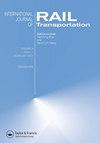铁路过渡地带:现有过渡结构的评估和新提议的过渡结构
IF 3.6
2区 工程技术
Q2 TRANSPORTATION SCIENCE & TECHNOLOGY
International Journal of Rail Transportation
Pub Date : 2023-10-26
DOI:10.1080/23248378.2023.2272668
引用次数: 0
摘要
这项全面的研究解决了铁路过渡区退化的持久问题,评估了最常用的缓解措施的有效性,并提出了一种新的过渡结构的安全船体激励能量限制设计(SHIELD)。首先,本文使用常用的响应(运动学响应和应力)和最近提出的基于总应变能最小化的准则来评估传统的过渡结构,包括水平和倾斜的过渡板和过渡楔。本文第二部分对新引入的过渡结构(SHIELD)进行了评价,采用了与传统过渡结构评价相同的准则。使用二维有限元模型对现有设计和新设计进行了详细调查,结果表明SHIELD在管理过渡区能量流方面是有效的,并提供了其他常用过渡结构无效的原因。研究表明,新建立的能量准则具有较强的鲁棒性和全面性,适用于不同类型的过渡带。此外,它还强调了SHIELD作为解决与铁路过渡区设计相关的复杂性的解决方案的潜力。本文章由计算机程序翻译,如有差异,请以英文原文为准。
Railway transition zones: evaluation of existing transition structures and a newly proposed transition structure
This comprehensive study addresses the persistent issue of railway transition zone degradation, evaluating the efficacy of the most commonly used mitigation measures and proposing a novel Safe Hull-Inspired Energy Limiting Design (SHIELD) of a transition structure. Firstly, this work assesses the traditional transition structures, including horizontal and inclined approach slabs and transition wedges, using commonly studied responses (kinematic response and stress) and a recently proposed criterion based on total strain energy minimization. The second part of the paper evaluates the newly introduced transition structuress (SHIELD) using the same criterion as used for the evaluation of the traditional transition structures. A detailed investigation of existing and a new design using a 2-dimensional finite element model shows SHIELD’s effectiveness in managing energy flow at transition zones and provides reasoning behind the ineffectiveness of the other commonly used transition structures. The study demonstrates the robustness and comprehensiveness of the recently developed energy-based criterion and its applicability to different types of transition zones. Moreover, it highlights the potential of SHIELD as a solution to address the complexities associated with the design of railway transition zones.
求助全文
通过发布文献求助,成功后即可免费获取论文全文。
去求助
来源期刊

International Journal of Rail Transportation
TRANSPORTATION SCIENCE & TECHNOLOGY-
CiteScore
6.90
自引率
15.00%
发文量
51
期刊介绍:
The unprecedented modernization and expansion of rail transportation system will require substantial new efforts in scientific research for field-deployable technologies. The International Journal of Rail Transportation (IJRT) aims to provide an open forum for scientists, researchers, and engineers in the world to promote the exchange of the latest scientific and technological innovations in rail transportation; and to advance the state-of-the-art engineering and practices for various types of rail based transportation systems. IJRT covers all main areas of rail vehicle, infrastructure, traction power, operation, communication, and environment. The journal publishes original, significant articles on topics in dynamics and mechanics of rail vehicle, track, and bridge system; planning and design, construction, operation, inspection, and maintenance of rail infrastructure; train operation, control, scheduling and management; rail electrification; signalling and communication; and environmental impacts such as vibration and noise. The editorial policy of the new journal will abide by the highest level of standards in research rigor, ethics, and academic freedom. All published articles in IJRT have undergone rigorous peer review, based on initial editor screening and anonymous refereeing by independent experts. There are no page charges and colour figures are included in the online edition free of charge.
 求助内容:
求助内容: 应助结果提醒方式:
应助结果提醒方式:


